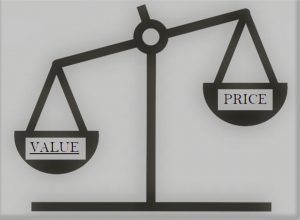Written by: Krishnakumar Ramanathan
About the author: Vice President – Sales (Transmission) at Siemens Limited.

This article is for B2B Sales & Marketing professionals, both present and aspiring. The journey of Sales & Marketing experience is the realisation that Price is secondary to Value – and while related, these are very different propositions indeed. Understanding this difference and learning to package Value into customer offerings is fundamental to the growth of a sales professional. It has a profound impact on one’s career advancement, and it may be safely said that those who understand Value better will move up their organisation faster.
When I started working in 1992, it was still a “Seller’s market”, one in which Manufacturers/Sellers generally held the balance of power to determine what needed to be sold, how, and at which price points. It was also a time when the Indian economy was opening up, with financial reforms leading to liberalisation and open markets. This offered new freedom of choice for the User/Buyer. Within a short time, as the impact of liberalisation began to be felt, the balance of power started to shift away from the Manufacturer/Seller to the User/Buyer. Progressively from there onwards, it has become a “Buyer’s market”, with the User/Buyer determining what they wanted to buy, how they wanted to buy it, and at which price points.
This shift of power led to the emergence of Value-based selling as against Price-based or Transactional selling, as the Buyer now had multiple options at different price points, and was in a position to choose the option which gave them the best value for money. The Seller had to now demonstrate tangible value to tip the Buyer’s decisions in their favour. Initially, this concept was alien to most Sellers, and it took time to change mindsets and overall approach. Today, Value selling is accepted widely across Sales and Marketing, more so in the B2B area. The focus is on the Value, while Selling is more of a consequence. This approach is therefore termed as creating a “Value Proposition”. Sales and Marketing professionals need to package their Value Propositions, in such a way that they stand out, have recall value, and deliver a higher probability of success for their Sales efforts. A few tips from my own experiences, as
below.
- Domain knowledge – The same products may be sold to different industries; but if I was addressing a customer from the cement industry, for example, then I made sure that my value proposition was specific to the Cement industry. I tried to study and understand the domain well – what were the cement industry’s largest challenges? What were my customer’s stated objectives? For example, if my customer had sustainability goals listed in their Annual report, like improvement in efficiency or reduction in emissions, then I built my Value proposition around the theme where I could find a relevant match with my offering
- Identify KPIs – Once I identified a theme (say, Energy Efficiency, because there was a matching portfolio) then a Value proposition was built up. How many non-energy efficient products are presently under use? What would be the investment needed to replace them? What would be the payback time? What would be the life-cycle savings for the customer? I have seen that often, customers are surprised when they see the extent of total savings possible. Showing them the change in KPI as well as an attractive RoI helps to move the discussion forward
- Best partner – This is where you need to close the deal in your favour, after building the customer’s awareness and kindling their interest in your value proposition. You may have impressed the customer with your domain knowledge, and piqued their interest by showing them how you can improve their KPI, but these don’t ensure business. For clinching that argument, you need to explain why you are the best partner – in terms of technology, track- record, or speed of implementation. This builds their confidence to entrust you with the business
At the end of the day, a Value proposition is about creating a “win-win” situation. It is about working for the customer’s success, by offering a tailored Value proposition that helps them improve their performance. A good value proposition also creates a long-term positive impact for both organisations.
